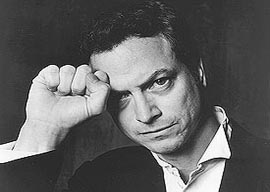
November 07, 2012

Gary Sinise
And yet, it’s worth thinking about sex hormone influences on voting. One of the funnier examples of the current Feminist Frenzy was CNN spiking a health post about the impact of women’s monthly cycles on their political leanings. In the struggle to re-elect Obama, no untoward thought can be allowed to go unresented and unrepressed by the auxiliary thought police.
In contrast, a recent Economist article, Political strength: A man’s muscle power influences his beliefs,” on a different evolutionary psychology study of the political impact of male hormones aroused little uproar:
Dr Petersen and Dr Sznycer found that, regardless of country of origin or apparent ideology, strong men argued for their self interest: the poor for redistribution, the rich against it. No surprises there. Weaklings, however, were far less inclined to make the case that self-interest suggested they would.
The politics of women, on the other hand, were uninfluenced by their muscularity. Sensibly, “Rich women wanted to stay rich; poor women to become so.”
This correlation between male muscularity and politics seems plausible to me, especially with the researchers” clever distinction between proclaimed ideology and political self-interest. (I would expect that strength also correlates with solidarity, that team spirit is stronger on the football field than on, say, the tennis team.)
For example, the rare out-of-the-closet Republican in Hollywood is typically an action movie star.
Likewise, the strong right arm of the Democratic Party was long a beefy union guy in a windbreaker. Or, in the case of my late father-in-law, the classical tuba-playing head of the Chicago Federation of Musicians, a beefy union guy in a tuxedo. To weedier musicians, he looked like what he was: a big man who wouldn”t back down in negotiations with the bosses.
In contrast, liberal college professors are frequently ectomorphic runners.
This study raises the follow-on question of whether political predilections are in-born, or if changes in exercise routines can influence opinions.
I often read liberals lamenting how much, holding demographics equal, the country has shifted to the right since the good old days of the mid-1970s. (Note: the mid-1970s may not have been that good for you.)
It occurs to me now that 1974, when the Democrats swept Congress, might have been the skinniest year in recent American history. The jogging craze had been kicked off by Frank Shorter’s gold medal in the 1972 Olympic marathon. And weightlifting was completely out of fashion, endorsed mostly by weirdoes like that freakish Austrian bodybuilder with all those consonants in his name.
I don”t know how to explain to younger people just how absurd the idea that muscle man Arnold Schwarzenegger would someday be elected governor of California would have struck people in 1974. By 1984, however, a profile of Schwarzenegger in Rolling Stone wisely devoted a paragraph to explaining that Arnold was Constitutionally ineligible to become President.
Here’s an extremely anecdotal Hollywood example of the political correlates of lifting v. running. Consider two television stars of highly rated cop shows: Gary Sinise (CSI: NY) and Mark Harmon (NCIS). These two actors strike me as reasonably comparable, perhaps because I used to see them around my son’s high school, Notre Dame in Sherman Oaks, where their children went. And, I”ve admired both Sinise and Harmon for their work long before they became television leading men. Sinise was the artistic director in the 1980s of Chicago’s great Steppenwolf theater. And Harmon had a 17-5 won-loss record quarterbacking my favorite college football team, UCLA, in 1972-73.
If I”d had to guess their political causes based on their biographies “ Sinise the Chicago theater kid whose father was a film editor v. Harmon the Bel-Air jock whose dad, Tom Harmon, won the 1940 Heisman Trophy “ I would have bet on Sinise as a liberal and Harmon as a conservative.
In reality, their political activism is closer to the body types they”ve worked to develop and maintain. Neither is a big man, but Sinise looks like he lifts weights. Even though Harmon is the rare Hollywood star who was a genuine football hero “ his slight frame must have taken a tremendous beating as the running QB of the Bruins” wishbone offense “ he hasn”t been much into putting on muscle since. Instead, he’s a distance runner.
Sinise is one of Hollywood’s most outspoken activists in a variety of conservative and patriotic causes. More than a few Republican operatives would like Sinise to carry on the Reagan-Schwarzenegger tradition by running for office.
In contrast, Harmon has been a gun control activist since his wife Pam Dawber’s costar Rebecca Schaefer was murdered by some stalker with a gun in 1989.
I don”t expect anybody to be terribly persuaded by this Sinise-Harmon comparison. My point, though, is that the proposition that different types of exercise could drive political views could be ethically tested on college students by offering free personal trainers. Randomly assign some volunteers to the weightlifting trainer, others to the running trainer, and measure if their attitudes change along with their shapes.
As Obama’s calculatedly divisive 2012 campaign demonstrates, the future of politics may look much stranger than what we”re familiar with. The parties will likely want to research how they can mold their own voters.